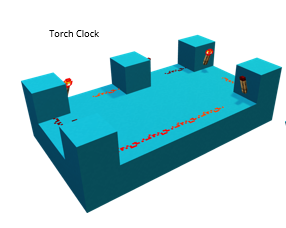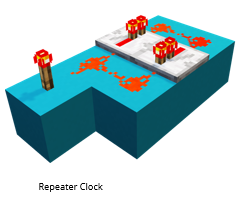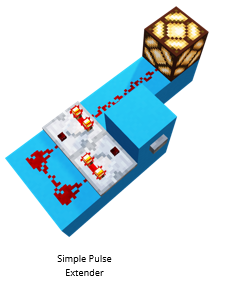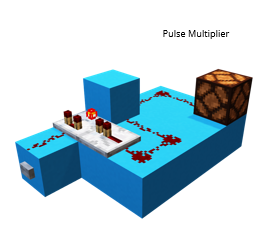Teach: Part 4—Simple circuits

Now we have the tools and Redstone knowledge needed to progress to creating circuits. The circuits featured in this unit are some of the easiest to make, but it only takes a simple circuit to create cool mechanisms. Clocks are commonly used to repeatedly activate a device, such as a piston or a dispenser. You could be protecting an area or changing the landscape of a maze.
Redstone clocks
Clocks are commonly used to repeatedly activate a device, such as a piston or a dispenser. You could be protecting an area or changing the landscape of a maze.
Torch clocks are the simplest clock circuit and utilize Redstone torches. They require an odd number of torches and use their ability to invert to turn sections on and off repeatedly.

Repeater clocks are common. It’s easy to amend the delay on Redstone repeaters and repeater clocks can be rapid. This repeater clock is a 1-tick version with no delay on the repeaters facing alternate directions. Remember to place the torch last. Otherwise, the signal will get stuck and stay on constantly.

Comparator clocks use a comparator set to subtraction mode to repeat a signal. It faces a solid block, from which Redstone dust loops into the side of the comparator via a repeater, so the Redstone doesn't join. The Redstone torch behind the comparator provides a signal of 15, so when the side input is subtracted, it still results in an output and a repeating loop.

On a hopper clock each output tube faces the other to create an alternating clock. Placing an item in one hopper will cause it to be passed back and forth indefinitely. The comparator beside each hopper measures each storage, which alternates between zero and one item, generating a small Redstone signal output. The signal is then amplified by the repeater.

Pulse circuit
The pulse circuit focuses less on multiple triggers and more on adapting signal duration as it travels through a circuit. A pulse extender could be used to build a combination lock.
This pulse extender receives its initial signal strength when the button is pressed. The strength of this signal is then passed through the two comparators, first at a signal strength of 15 and then at 14. As it performs this loop, the lamp will remain lit for longer than a standard signal strength from pushing a button.

A pulse extender could be used to build a combination lock.
A pulse multiplier takes a signal pulse input and increases the number of pulses emitted, quickly activating a mechanism twice or more. The signal first passes through a solid block, powering the Redstone lamp, and along the loop next to it, passing the signal to the comparator set to subtraction mode. It passes through the solid block again but won’t reach the comparator as the first subtraction has reduced the signal strength.
